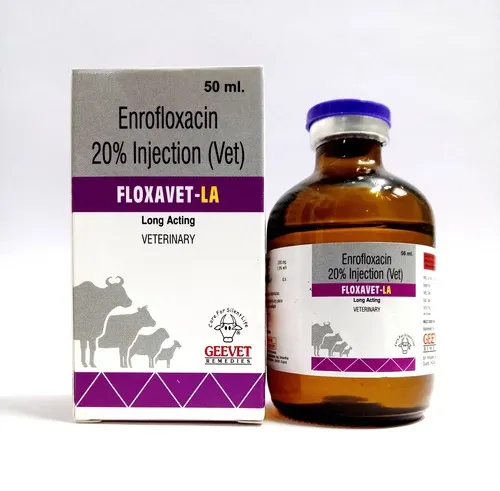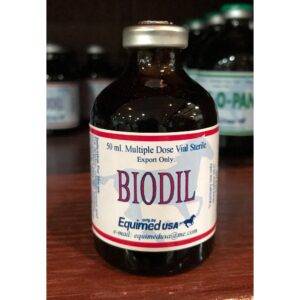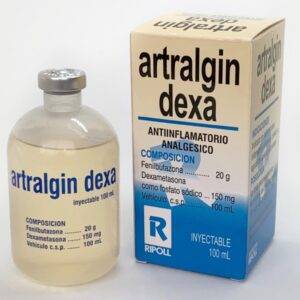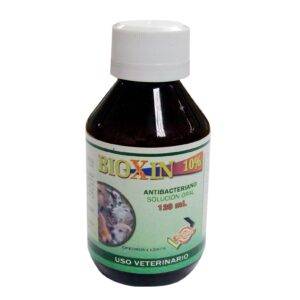Enrofloxacin
Enrofloxacin is a widely used fluoroquinolone antibiotic in veterinary medicine. It’s effective against a broad range of bacterial infections in animals, including dogs, cats, cattle, pigs, and poultry. In veterinary use, it is commonly sold under the brand names like Baytril, Enroflox, and many other generic forms. It is available in various formulations, including injectable solutions, oral tablets, and topical solutions.
Key Information About Enrofloxacin:
Mechanism of Action:
Enrofloxacin works by inhibiting bacterial DNA gyrase and topoisomerase IV, enzymes responsible for bacterial DNA replication, transcription, repair, and recombination. This halts bacterial growth and replication, making it effective against many Gram-negative and Gram-positive bacteria.
Available Forms:
Injectable solution: Typically used in larger animals like cattle, pigs, and horses.
Oral tablets or solutions: Often used in small animals like dogs and cats.
Topical formulations: Sometimes available for specific infections like ear or skin infections.
Uses in Veterinary Medicine:
Respiratory infections: Enrofloxacin is commonly used to treat pneumonia, bronchitis, and other respiratory diseases caused by bacterial infections.
Urinary tract infections (UTIs): Effective in treating infections of the bladder, kidneys, and other parts of the urinary system.
Gastrointestinal infections: Bacterial infections of the stomach or intestines.
Skin and soft tissue infections: Used for wounds, abscesses, and other infections of the skin and tissues.
Septicemia: Blood infections caused by bacteria.
Reproductive tract infections: Effective against infections in the reproductive organs, such as uterine infections.
Joint and bone infections: It is sometimes used for bacterial arthritis or osteomyelitis.
Enrofloxacina Injection (Injectable Form):
Concentration: The injectable form of enrofloxacin typically comes in 5% or 10% concentrations, meaning that there is 50 mg/ml or 100 mg/ml of enrofloxacin in the solution.
Route of Administration: The injectable form is usually given intramuscularly (IM) or subcutaneously (SC), depending on the species and condition being treated.
Dosage: The dosage will vary depending on the type and weight of the animal and the severity of the infection. Typical doses range from 2.5 to 10 mg/kg of body weight per day, administered for 5-10 days, but always follow the veterinarian’s prescription.
Species-Specific Uses:
Dogs and Cats: Used to treat respiratory infections, urinary tract infections, skin infections, and ear infections. Oral formulations are often preferred for small animals, though the injectable form can also be used in severe cases.
Cattle and Swine: Commonly used to treat bacterial pneumonia, mastitis, and infections in the reproductive or gastrointestinal systems.
Poultry: Used for the treatment of respiratory infections such as avian colibacillosis caused by Escherichia coli.
Horses: Sometimes used for respiratory infections, skin infections, and septicemia in horses, though not as commonly as in other livestock species.
Benefits of Enrofloxacin:
Broad-Spectrum Antibiotic: Effective against a wide range of bacteria, including both Gram-negative and Gram-positive bacteria.
Quick Absorption: When administered, especially via injection, enrofloxacin is absorbed quickly and reaches therapeutic levels in the bloodstream and tissues.
Wide Distribution: The drug penetrates well into tissues, making it effective for infections in various organs and systems.
Lower Risk of Resistance: Compared to some other classes of antibiotics, enrofloxacin has a lower risk of developing resistance when used appropriately.
Side Effects:
Gastrointestinal Issues: Vomiting, diarrhea, and loss of appetite may occur, especially in small animals.
Joint and Cartilage Damage: In young or growing animals, prolonged use can cause damage to developing cartilage, leading to joint issues. This is especially a concern in puppies and young dogs.
Neurological Effects: Rarely, enrofloxacin can cause seizures or tremors in animals with underlying neurological conditions.
Allergic Reactions: Some animals may have an allergic reaction, causing symptoms like swelling, hives, or difficulty breathing.
Photosensitivity: In rare cases, enrofloxacin can cause increased sensitivity to sunlight, particularly in light-colored animals.
Precautions:
Avoid in Young Animals: As mentioned, enrofloxacin should be avoided in puppies and kittens due to the risk of joint and cartilage damage.
Not Recommended for Pregnant or Lactating Animals: Limited data are available on the safety of enrofloxacin during pregnancy or lactation.
Avoid in Animals with Seizure Disorders: Enrofloxacin may lower the seizure threshold, making animals more prone to having seizures.
Drug Interactions: Certain medications, like antacids or calcium supplements, can reduce the absorption of enrofloxacin when administered orally.
Contraindications:
Known Hypersensitivity: Enrofloxacin should not be used in animals with known hypersensitivity or allergy to fluoroquinolones.
Growing Animals: Avoid use in young animals, especially puppies under 12 months (for small breeds) or 18 months (for large breeds), due to the risk of cartilage damage.
Withdrawal Periods in Livestock:
Meat Withdrawal: If enrofloxacin is used in food-producing animals like cattle, swine, or poultry, a withdrawal period must be observed before the meat is processed for human consumption. The withdrawal period typically ranges from 5 to 28 days, depending on the species and country regulations.
Milk Withdrawal: If used in dairy cattle, there is usually a milk withdrawal period (which can range from 3 to 6 days) to prevent antibiotic residues in milk.
Enrofloxacin in Horses:
Enrofloxacin can be used for treating bacterial infections in horses, though its use is less common than in cattle or swine. It may be used for respiratory infections and other systemic bacterial diseases. However, due to its potential side effects, especially in growing horses, it should be used cautiously and only under the guidance of a veterinarian.
Resistance Issues:
Like all antibiotics, overuse or misuse of enrofloxacin can lead to the development of bacterial resistance. To reduce the risk of resistance, enrofloxacin should be used according to a veterinarian’s prescription, and full treatment courses should be completed even if the animal seems to recover quickly.
Conclusion:
Enrofloxacin is a highly effective, broad-spectrum antibiotic commonly used in veterinary medicine for treating bacterial infections. Its injectable form is particularly useful for severe infections or in cases where oral medication is not feasible. It is widely used in both small and large animals, including dogs, cats, cattle, pigs, and poultry. However, it comes with potential side effects, especially in young animals, and should be used with caution.





Reviews
There are no reviews yet.